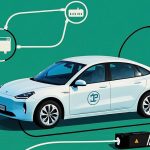Introduction
In an era where speed and sustainability define transportation progress, two technologies vie for dominance in the high-speed rail revolution: magnetic levitation (maglev) trains and hyperloop systems. While Japan’s L0 Series maglev hits 375 mph (603 km/h) and Virgin Hyperloop’s prototype reaches 240 mph (387 km/h) in low-pressure tubes, the battle transcends speed. This article dissects their engineering philosophies, economic viability, and geopolitical implications, asking: Which technology will reshape global mobility?
1. Technology Showdown: Maglev vs. Hyperloop
1.1 Magnetic Levitation: Floating on Electromagnetism
Maglev trains use superconducting magnets to levitate 4 inches (10 cm) above guideways, eliminating wheel friction. Current systems include:
- Shanghai Transrapid (China): Operational since 2004, connects Pudong Airport to downtown (19 miles/30.6 km) at 268 mph (431 km/h).
- Chūō Shinkansen (Japan): Under construction, will link Tokyo to Nagoya (178 miles/286 km) in 40 minutes by 2027.
Key Advantages:
- Proven reliability: Shanghai’s maglev has transported 60 million passengers with zero fatalities.
- Energy efficiency: 30% less energy per passenger-mile than airplanes.
Limitations:
- Infrastructure costs: 200–200–300 million per mile for guideways.
- Limited scalability: Requires straight tracks; unsuitable for mountainous regions.
1.2 Hyperloop: Speed in a Vacuum
Proposed by Elon Musk in 2013, hyperloop pods travel through near-vacuum tubes at near-supersonic speeds. Key players:
- Virgin Hyperloop: Completed first crewed test (107 mph/172 km/h) in 2020; aims for 670 mph (1,080 km/h).
- Hardt Hyperloop (Netherlands): Testing a European network prototype with lane-switching technology.
Breakthrough Innovations:
- Passive magnetic levitation: Uses permanent magnets, cutting energy use by 60%.
- Air bearings: Compressed air cushions reduce friction to 0.001 psi.
Critical Challenges:
- Tube pressurization: Maintaining a 99.9% vacuum across thousands of miles is untested.
- Passenger safety: Emergency depressurization protocols remain theoretical.
2. Infrastructure Economics: Costs vs. Benefits
2.1 Construction Costs Breakdown
| Technology | Cost per Mile (USD) | Key Expenses |
|---|---|---|
| Maglev | 200–200–300 million | Guideway magnets, power substations |
| Hyperloop | 50–50–100 million* | Steel tubes, vacuum pumps, stations |
| Traditional HSR | 25–25–40 million | Tracks, electrification |
*Virgin Hyperloop claims costs could drop to $30 million/mile with scale.
Case Study: California’s Failed Maglev Project
In 2008, a proposed maglev line between Anaheim and Las Vegas (269 miles/433 km) was scrapped due to a 12billionpricetag.Conversely,Nevadaapproveda12billionpricetag.Conversely,Nevadaapproveda500 million hyperloop test track in 2022.
2.2 Operational Efficiency
- Energy use: Hyperloop consumes 76 kWh per 100 passenger-miles vs. maglev’s 110 kWh (U.S. DoE).
- Maintenance: Maglev’s guideways require 50% less upkeep than conventional rail.
3. Geopolitical Battlegrounds
3.1 China’s Maglev Diplomacy
Through its Belt and Road Initiative (BRI), China exports maglev technology to:
- Egypt: $9 billion Luxor-Hurghada tourist line (2026 completion).
- Malaysia: Kuala Lumpur-Singapore maglev proposal to rival Airbus dominance.
Strategic Goal: Challenge Japan’s Shinkansen and Europe’s TGV as the global rail standard.
3.2 Hyperloop’s Private Sector Alliance
Western startups avoid state partnerships, focusing on corporate alliances:
- DP World (Dubai): Funding 70% of Virgin Hyperloop’s $500 million Dubai-Abu Dhabi cargo project.
- European Green Deal: Subsidizing Hardt Hyperloop’s Rotterdam-Amsterdam route to replace short-haul flights.
4. Urban Integration: Noise, Land Use, and Public Acceptance
4.1 Noise Pollution Solutions
- Maglev: Shanghai uses sound-dampening barriers that reduce noise to 65 dB (equivalent to a dishwasher).
- Hyperloop: Encapsulated tubes limit external noise to 50 dB (library-level quietness).
4.2 Land Acquisition Challenges
- Maglev: Japan’s Chūō Shinkansen required tunneling through 86% of its route, triggering $63 billion cost overruns.
- Hyperloop: Elevated tubes minimize land disruption but face zoning disputes. India’s Pune-Mumbai hyperloop was delayed after farmer protests.
5. Case Study: Germany’s Transrapid Disaster
Germany pioneered maglev tech with the 1984 Transrapid, yet abandoned it in 2011 due to:
- High costs: Munich Central Station retrofit estimates hit €3 billion.
- Public distrust: A 2006 crash killing 23 doomed political support.
Lesson: Technology alone cannot succeed without cost controls and societal buy-in.
Future Outlook: 2040 and Beyond
- Maglev: Expected to dominate intracontinental routes (e.g., Beijing-London via BRI).
- Hyperloop: Likely to serve high-value cargo and <500-mile passenger corridors (e.g., Chicago-Toronto).
- Wildcard: China’s “Ultra-High-Speed Pipeline Train” hybrid (maglev + hyperloop principles) entering trials in 2025.

















